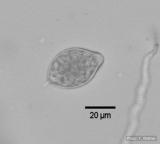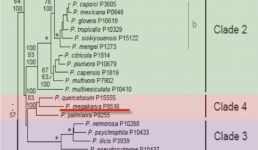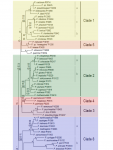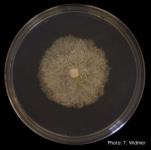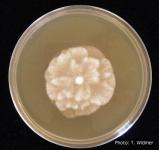Phytophthora megakarya
The only economically important host of Phytophthora megakarya Brasier & Griffin is Theobroma cacao. The pathogen is one of several Phytophthora species causing black pod disease of cacao. Isolates of P. megakarya were grouped taxonomically with P. palmivora isolates until 1979, when it was recognized as a new species (Brasier and Griffin, 1979). Found only in Central and West Africa, losses due to black pod disease caused by P. megakarya can be 50-80% in nontreated areas (Despréaux, 2004).
Etymology: Derived from ‘large’ (mega) ‘karyotype’ (karya) due to the larger chromosomes compared to P. palmivora.
P. megakarya is heterothallic with amphigynous antheridia and distinctly pyriform oogonia. The caducous sporangia are papillate, varying in shape from limoniform, obpyriform, and ellipsoid. Terminal chlamydospores have an average diameter of 30 µm.
P. megakarya is in phylogenetic clade 4, closely related to P. arecae, P. palmivora, P. quercina, and P. quercetorum (Balci et al., 2008).
http://phytophthora-id.org/ is a good web-based, searchable database for rapid identification of Phytophthora species based on sequencing of the internal transcribed spacer (ITS) or the cytochrome oxidase (cox) 1 and 2 spacer regions followed by BLAST searching the database. Both databases are highly selective and include only sequences that are associated with published Phytophthora species descriptions or classic Phytophthora phylogenetics references.
Phylogenetic trees from http://www.phytophthoradb.org/species.php
Colonies on V8 agar grow in a stellate pattern with aerial mycelium; hyphae are coralloid. Growth on CMA is sparse with no aerial mycelium.
P. megakarya differs from P. palmivora morphologically by its narrow, medium length sporangium pedicels compared to broad, short, and occluded pedicels of P. palmivora and the pyriform, tapering downward oogonia compared to the spherical, narrow stalk oogonia of P. palmivora (Erwin and Ribeiro, 1996). P. quercetorum (Balci et al., 2008) and P. quercina (Jung et al., 1999), both in Clade 4, are homothallic in culture while P. megakarya is heterothallic.
For more information about Phytophthora megakarya, visit our Disease, Education and Management materials, and Reference sections.



